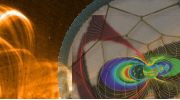
CONTACTS
|

Project SummarySatellites in space are exposed to fluxes of relativistic charged particles that vary in intensity by many orders of magnitude on time scales ranging from hours to years. Space radiation has significant impact on spacecraft design, program costs, and mission capabilities. Yet, we do not understand how radiation belt particles are accelerated, how they are lost, or how they vary in space and time. Much greater threats to space systems can be produced by artificial radiation belts injected into the space environment by high-altitude nuclear explosions (HANE). However, fundamental holes in our understanding of the processes that control the coupling of HANE output into the geomagnetic field cripple our ability to assess risks quantitatively. We propose an innovative program to develop a next-generation space radiation model using extensive satellite measurements, new theoretical insights, global physics-based magnetospheric models, and the powerful techniques of data assimilation. For both the natural and HANE environments, controlled experiments that isolate and test individual physical mechanisms are not possible. Therefore the next major breakthroughs in scientific understanding of those processes must come from data assimilation based modeling. We will develop, test, and validate the model using the natural radiation environment to ensure that we can extrapolate it to the poorly observed conditions during the most extreme natural and man-made events. In developing and testing this important predictive capability we answer one of the most tantalizing outstanding questions in space physics: What accelerates electrons to relativistic energies in the Earth's relatively weak magnetic field? |